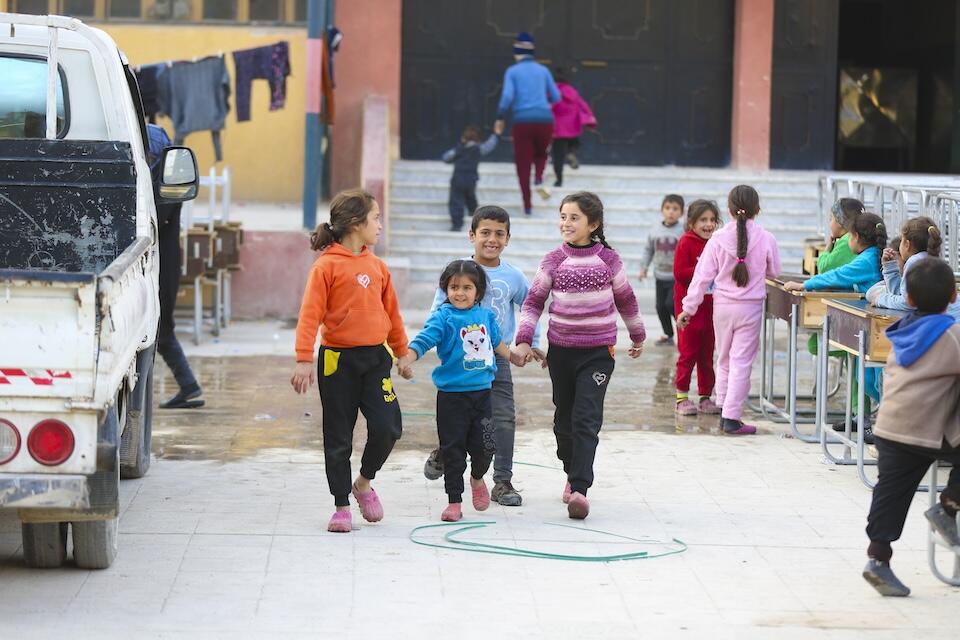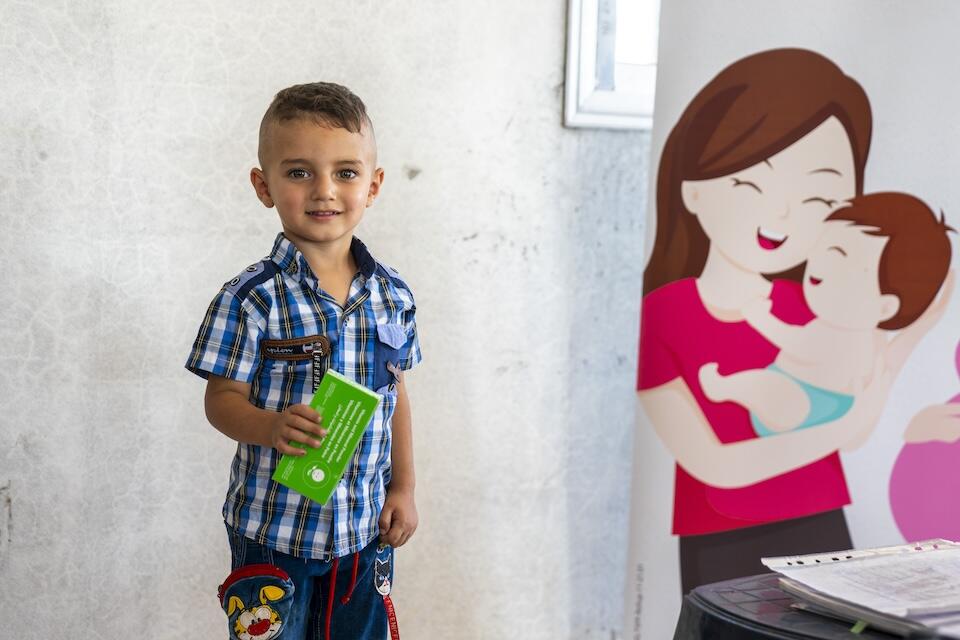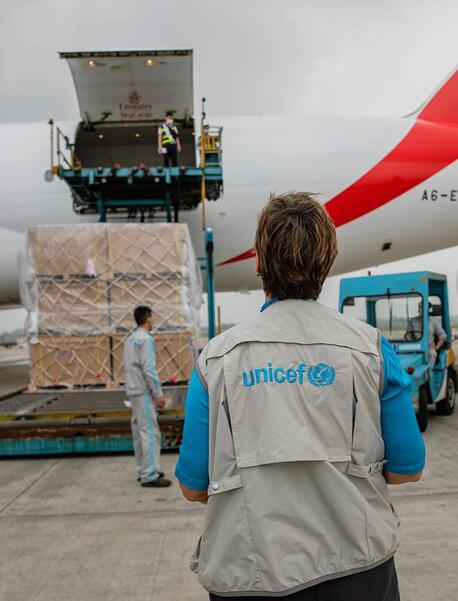
UNICEF Seeks Support to Ramp Up Aid to Children in Syria
A 'Whole of Syria' approach is guiding UNICEF’s response to one of the world's most complex humanitarian crises fueled by new waves of violence and displacement. An influx of refugees from Lebanon into Syria has further strained the country's systems, already weakened by over a decade of civil conflict. A look at key areas where UNICEF is already making a difference for children and families — and could do more with more donor support.
Few crises in the world are as complex as Syria’s.
The country has been suffering the impacts of civil war since 2011. Natural disasters, including the February 2023 earthquakes, on top of public health emergencies, economic and climate-related shocks and widespread protracted displacements have compounded humanitarian needs. So has an influx of over half a million refugees fleeing escalating conflict in Lebanon — many of them Syrian returnees.
Then, late last month, fighting within Syria erupted yet again, leading to the most intense and deadliest period of violence inside the country since 2018. Another 1 million people — mostly women and children — were displaced from Aleppo, Hama, Homs and Idlib governorates just since Nov. 28, the UN Office of Coordination of Humanitarian Affairs (OCHA) reported.
Even before this latest escalation, nearly 17 million people in Syria required humanitarian aid, including 7.5 million children. Needs are most acute in the northwest and northeast regions.
UNICEF is committed to stay and to continue delivering vital assistance to alleviate the suffering of children and their families — but more flexible funding support is needed.
UNICEF in Syria: Alleviating children’s suffering, ensuring their survival — and unlocking their potential to thrive
With a presence inside Syria since 1970, UNICEF was able to deploy an emergency response when civil war first erupted. Today, UNICEF continues to lead interventions in key areas, delivering support and protection to Syrian children who were born into violence and deprivation and continue to face daily threats to their well-being and future.
A 'Whole of Syria' approach ensures efficiency, prioritization and coordination across multi-agency efforts as additional emergency measures get underway in response to more recent developments.
The approach includes identifying communities with the greatest needs, monitoring and tracking results — all crucial for optimizing the use of resources.

Here are some examples of the many challenges and risks facing children in Syria, and how UNICEF is working with partners to address them.
Health
Challenges: Almost 40 percent of hospitals and health facilities in Syria are partly or completely non-functional, disrupting essential services or halting them altogether; displacement due to conflict or other crises exacts a heavy toll on children’s mental health.
In response, UNICEF supports teams that provide essential health services including immunizations, psychological First Aid and screenings through mobile and fixed clinics. UNICEF's target for 2025 is to support 1.7 million children and women with access to primary health care.
WASH (Water, sanitation and hygiene)
Challenges: Climate-induced shocks and power supply disruptions have intensified water scarcity and food insecurity, leaving nearly 13.6 million people without access to basic WASH services; centers for families displaced by conflict are overcrowded and ill-equipped, and poor displacement camp conditions have led to a rise in cases of Acute Watery Diarrhea.
In response, UNICEF works with partners to repair power lines to get water pumping systems back online, and otherwise restore access to safe water; distribute soap and other essential sanitation and hygiene items; install emergency latrines and otherwise improve WASH facilities in displacement shelters and reception centers; and promote handwashing and other hygiene practices to prevent disease outbreak.
In 2025, UNICEF aims to reach 3.9 million people with sufficient access to safe water.
Nutrition
Challenges: Poverty, high commodity prices and other factors have left 5.7 million people across Syria, including 3.7 million children, in need of nutritional support. Displaced children are especially at risk of acute malnutrition.
In response, UNICEF supports nutrition screenings and the distribution of supplements and other supplies to prevent and/or treat malnutrition in children and pregnant and lactating women. In 2025, UNICEF aims to reach 1.5 million primary caregivers with infant and young child feeding counseling.
Protection
Challenges: Children in crisis are particularly vulnerable to exploitation, abuse and neglect; in Syria, 85 percent of all households struggle to make ends meet, increasing their risks of turning to child labor and other negative coping mechanisms. Across the country, insecurity and economic hardship continue to contribute to human rights violations, fear and psychological distress, leading to gender-based violence, child marriage and the risk of sexual exploitation and abuse. Prolonged absence from school increases the likelihood that a child drops out for good, while also leaving them vulnerable to trafficking and recruitment into armed groups. Unexploded ordnance remains a significant safety threat.
In response, UNICEF provides emergency humanitarian cash transfers to help families cover the basics; supports child protection awareness sessions and mine risk reduction education; opens and staffs child-friendly spaces that offer safe places to learn, play and receive psychosocial support; and provides opportunities for children to get back to school and stay there.
Education
Challenges: Thousands of schools in Syria have been damaged or destroyed, drastically curtailing education services for millions of children in Syria. More than 12,000 schools were forced to close in the past two weeks alone, and over 1,000 schools are being used as shelters for displaced families. More than 1 million children, particularly those with disabilities, are at risk of dropping out of school.
In response, UNICEF is rehabilitating schools, supporting teacher salaries, offering non-formal education activities and setting up temporary learning spaces for displaced children. In 2025, UNICEF aims to reach 2.6 million children with educational services and supplies in formal settings.

During the first half of 2024, UNICEF reached over 4.6 million people in Syria with humanitarian assistance, including 2.7 million children (half of them girls), 1.2 million women and 40,885 with disabilities. In 2025, UNICEF aims to support 7 million people in Syria, including 4.3 million children under a plan that combines early recovery and resilience efforts to address immediate needs and achieve lasting results for children.
Learn more about UNICEF humanitarian action for children in Syria and program targets for 2025.
Flexible funding allows UNICEF and partners to respond with rapid and sustained action to changing needs on the ground
A big issue in Syria is that conflict and insecurity continue to disrupt critical transportation routes, limiting the movement of people and goods and also affecting the delivery of aid. UNICEF calls on all parties to cease hostilities immediately and to ensure the safety and security of humanitarian actors and to secure safe, unimpeded and unrestricted access to children and their families to deliver lifesaving support.
“This is critical to our ability to rapidly scale up our response to meet the growing humanitarian needs,” UNICEF Executive Director Catherine Russell said.
“UNICEF also calls on all parties to commit to a sustained peace, so that Syria’s children can survive and thrive,” Russell added. “The children in Syria have suffered enough. They deserve a future of peace, dignity and opportunity.”
Flexible funding is the best way to support a rapid, sustained and equitable humanitarian response in Syria. Investments are imperative to restore systems to deliver essential basic services, like education, water and sanitation, health, nutrition, social welfare and social protection, leaving no child behind. Donate today.
HOW TO HELP
There are many ways to make a difference
War, famine, poverty, natural disasters — threats to the world's children keep coming. But UNICEF won't stop working to keep children healthy and safe.
UNICEF works in over 190 countries and territories — more places than any other children's organization. UNICEF has the world's largest humanitarian warehouse and, when disaster strikes, can get supplies almost anywhere within 72 hours. Constantly innovating, always advocating for a better world for children, UNICEF works to ensure that every child can grow up healthy, educated, protected and respected.
Would you like to help give all children the opportunity to reach their full potential? There are many ways to get involved.





